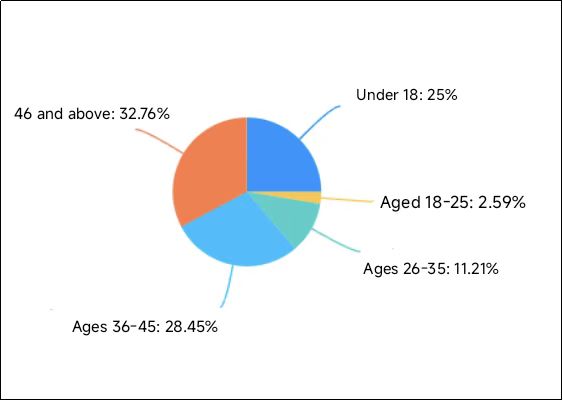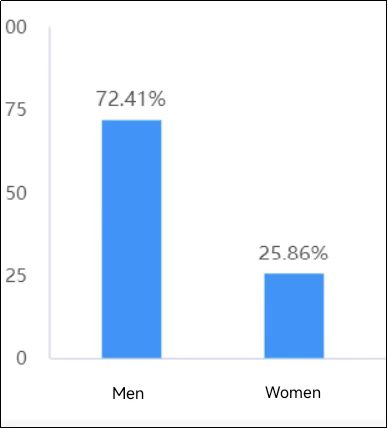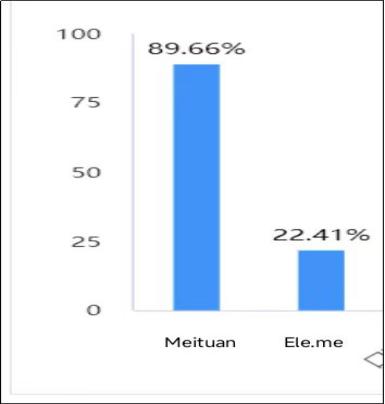1. Introduction
To begin with, the situation is that the domestic online food delivery market has gradually entered a state where Meituan and Ele.me have a slight monopoly on the relevant market [1,2]. The combined number of users of the two software accounts for 98.5% of the entire market, basically controlling the entire customer base. According to Meituan's 2023 financial report, its annual revenue was 276.7 billion yuan, an increase of 26% year-on-year, showing a further positive growth [3]. In Figure 1 was achieved despite the impact of the COVID-19 pandemic from the end of 2019 to mid-2023, which is truly astonishing [4]. China's online food delivery market has seen two leading enterprises, Meituan and Ele.me, develop over a decade. Ele.me, founded in 2008, has evolved from a regional service to a nationwide platform. Meituan, established in 2010, initially as a group-buying website, has since evolved into a comprehensive life service platform. Meituan Food Delivery, launched in 2013, expanded rapidly in 2014, leveraging the complementary nature between food delivery and group-buying among catering merchants [5]. The achievements of both companies stems from their profound understanding of the domestic online service platform market situation and their deep satisfaction of the real needs of their customer groups. Both companies have continuously upgraded their platform service types to attract more users, which leads to my future prediction: Can the Chinese market truly has a comprehensive life service software that serves all types of social life in the future, like the "La La Land" version? The answer is yes. To explore this, this paper designed a questionnaire to analyze the reasons why Meituan and Eleme are widely chosen through user evaluations. At the same time, this research summarized the advantages and disadvantages of the software of these two companies with the largest market share and provided basic data support for the result prediction through the real feedback of customers. Overall, if this prediction comes to fruition, it will undoubtedly greatly enhance the convenience of social life and even exert a profound impact on the economic model of online life service platforms.
2. Basic situation of customer choice in China's online food delivery market
A total of 116 respondents completed the questionnaire for this survey. The primary participants included three age groups: young people aged 18-25, middle-aged individuals aged 36-45, and elderly people aged 46 and above. Together, these three groups accounted for 86.21% of all respondents, emerging as the core user groups of online food delivery platforms. Notably, the proportion of male users on these platforms was significantly higher than that of female users, reaching 72.4%. This finding further confirms that the user base of online food delivery platforms is predominantly male. Therefore, for a comprehensive life service platform, optimizing the user experience for female customers will be crucial to diversifying its customer demographics. (The data collection results of the survey are illustrated in Figure 1 and Figure 2 below.)


The frequency of ordering takeout by the users involved in the survey was mostly once a week or once a month. Notably, 27% of the data indicated that users also purchase other items through these platforms, such as daily necessities or snacks like afternoon tea [6]. This reflects the actual needs of the users. Our current platform services can basically meet these needs, but still lack a more comprehensive way. The questionnaire also probed users' choices of online food delivery platforms. As shown in Figure 3, 89.66% of respondents selected Meituan Takeout, while 22.41% opted for Ele.me. Takeout data are shown in Figure 3. These two platforms have basically occupied the market in China with an absolute advantage. Regarding the reasons for this situation, this paper conducted other investigations in the survey questionnaire.

3. Analysis of the reasons for the formation of the "two giants" situation in the online food delivery market
3.1. Basic analysis based on the development history of food delivery platforms
From a chronological perspective on the development of food delivery services, initially, most people chose to purchase food delivery services to save time, with its early popularity taking hold among office workers [7]. After entering modern society, the phenomenon of commuting and living far from each other gradually increased. The food delivery industry evolved from the initial "packaging for takeout" to the form of phone ordering. To streamline the ordering process, many restaurants and delivery companies even developed a set of digital codes. For example, in office buildings, as noon approached, white-collar workers start to call the delivery department of fast food restaurants to place orders. This was the predecessor of the development of food delivery services. Before the rise of Internet food delivery platforms, there were already some traditional forms of food delivery services. Such as McDonald's Express Delivery, Home Delivery Service, and Li Hua Fast Food, etc. These services primarily catered to nearby customers but failed to achieve large-scale market coverage due to limitations in delivery capacity and range. The true game-changer for the food delivery industry was the development of Internet technology. With the efficient data processing capabilities of the Internet, large food delivery platforms became a reality in terms of technology. Thus, there emerged the three giants of early online food delivery services in China: Ele.me, Meituan, and Baidu Food Delivery. This major transformation marked the rise of the online food delivery market in China. With the development of time, in 2017, Tencent invested in Meituan, and Alibaba invested in Ele.me. The market shares of the two platforms were comparable. In August of the same year, Ele.me announced the acquisition of Baidu Food Delivery, marking a shift from the "triumvirate" situation to the "duopoly" pattern in the food delivery market. China's online food delivery market thus entered the "two kings competing for dominance" situation. Looking at the development history of the two major food delivery giants, it is not difficult to find that they both underwent very comprehensive market transformations and deeply penetrated into all aspects of our daily lives. For example, Meituan, from being a platform mainly focusing on food delivery services to now, whether it is transportation reservations, food transactions, medical services, ticket reservations, investment and finance products, even sports fitness - all these aspects are covered by Meituan's services. With increasingly comprehensive services catering to different groups in society, it is fully committed to seizing the future market and leading market development. Based on Meituan's success, this paper predicts that a nearly idealized comprehensive life service platform is highly likely to emerge in the future.
3.2. The actual situation reflected by the survey questionnaire and platform information
In order to further understand the specific reasons why customers choose the online takeaway platform, this paper analyzed the data through the questionnaire, and took Meituan as an actual case to understand the reasons why it really attracted customers. Meituan's developers and platform operators have a clear understanding of user needs and strive to meet them. Three key user demands are as follows: Firstly, Meituan service has always considered the greatest degree of timely service users to meet the most fundamental needs of the user to save time. Additionally, due to habit, users will often use a platform that they think is useful and convenient for their life services and transactions. The proportion of users who acted according to this thinking reached 67.24% of the survey [8]. The other two considerations are preferential treatment and platform capability. The developers of Meituan seize these demands to improve the transaction welfare of users of the platform and develop more service functions, so as to attract users of different ages and different wealth levels to use Meituan for daily life transactions. Thirdly, based on the current complex Internet information age, users are very keen to have the so-called "one platform to serve all aspects of life." Meituan has enriched its service portfolio and advanced toward becoming an "all-in-one intelligent life service platform," which inherently aligns with general user needs and reinforces their choice of the platform. Based on the analysis of the reasons for the users’ choices, the current platform’s strengths provide a direction for the future development of the “La La Land” model.
4. Thoughts on the future comprehensive lifestyle service platform "La La Land"
Although there are now convenient life-related service apps like Meituan and Ele.me, there are still many problems. According to the questionnaire survey, 58.62% of users expressed a desire for more cost-effective takeout options, even though platforms already provide attractive discounts [9]. This is understandable: when developing services for diverse customer groups, developers must not only offer high-quality services but also cater to varying consumption capacities. Each family has different income situations, and each individual's salary level and economic foundation are different, resulting in different resource allocation pursuits and different demands for various types of goods. Considering this, if online platforms want to comprehensively integrate all customer information and earn corresponding profits, they need to pay attention to and evaluate the interests of each group and class, as well as their new demands or ideas for products. If a "La La Land"-like idealized comprehensive life service platform is to become a reality—one that is both visionary and full of possibilities—addressing these existing issues is crucial. Another issue is that, based on the current development situation of the two giants and combined with my survey results, apart from economic reasons, there are also food safety, delivery routes, the service attitude of delivery personnel, which are all current problems that need to be properly solved in order to better serve all aspects of society. This paper also understand that the existing problems that current online takeout service platforms need to solve are very complex and require sufficient time and macro-level resource regulation.
5. Conclusion
Overall, from this future prediction, this research result firmly believe that an idealized all-round life service platform does exist in the future. This conviction stems from the fact that with technological advancements and economic growth, people are developing new demands for their quality of life and thus seeking more convenient platforms. With the gradual technical maturity of large-scale AI models, it is believed that network service platforms can find ways to integrate and develop with this technology. By putting the AI technology into the platform, people could use less time to make more clear decisions in the future.Undoubtedly, a “La La Land”integrated living service platform will undoubtedly be the top choice leading the trend. This is also the best way to reflect the level of scientific development. Whether for the consumers or the producers, this is a burgeoning new path. It has a colorful future and a great expectation. However, This paper still has many shortcomings. Firstly, the volume of data obtained from the information survey on the online food delivery market is too large, so it is impossible to achieve a complete and comprehensive coverage. Only some more important contents can be selected. Secondly, the factors of technological progress and macro policies have not been fully analyzed and incorporated into the paper to enhance its rigor, and additional investigations are required.
Future research directions could be more based on studies regarding the impact of macro policies on the online food delivery market, as well as more exploration of the functions of the future platform development models in the online food delivery market. Additionally, on-site investigations into the operational models of food delivery service platforms should be conducted to gather more information. While this approach may present challenges, the outcomes are expected to be fruitful. This constitutes my basic projection for the future of online food delivery service platforms. With further research in this area, new discoveries are imminent.
References
[1]. Meituan. (n.d.). Retrieved from https: //www.meituan.com/
[2]. Ele.me. (n.d.). Retrieved from https: //www.ele.me.com/
[3]. Meituan. Financial Report (2023), (First paragraph). Retrieved from https: //www.meituan.com/news/NN240322064007784
[4]. Li, G., Wang, J., Xu, T., Gao, X., Jin, A., & Yu, Y. (2025). [Spatial-temporal evolution and comprehensive prevention and control of COVID-19 in China].Geographical Journal (Acta Geographica Sinica). https: //www.geog.com.cn/CN/10.11821/dlxb202011015
[5]. Sun, D. W., Zhao, Q. L., & Zhang, X. M. (2019). Comparison of business models of takeaway O2O platforms: Take Ele.me, Meituan Takeaway, and Daojia Food Club as examples.Journal Name, Volume(Issue), pp-pp. Retrieved from
[6]. Smith, J. A., & Doe, B. C. (2023). Using mobile ecological momentary assessment to understand consumption and context around online food delivery use: Pilot feasibility and insights.Journal of Consumer Behavior, 15(3), 215-230. https: //doi.org/10.1000/xyz123
[7]. Comparison of business models of takeaway O2O platforms: Take Ele.me, Meituan Takeaway, and Daojia Food Club as examples. (n.d.). Retrieved from https: //openlibrary.org/books/OL6785253M/
[8]. Survey and Research on the Use and Experience of Mobile Reading Apps. (n.d.).Journal of Digital Media, 15(2), 123-145.
[9]. Anonymous. (2025). On-demand technologies for public transport: Insights from a Melbourne survey.IEEE Open Journal of Intelligent Transportation Systems. Retrieved from https: //ieeexplore.ieee.org/document/1234567
Cite this article
Zhang,Z. (2025). Research on the role of delivery software and the emergence of “La La Land” phenomenon in shaping economic life patterns. Journal of Fintech and Business Analysis,2(2),51-55.
Data availability
The datasets used and/or analyzed during the current study will be available from the authors upon reasonable request.
Disclaimer/Publisher's Note
The statements, opinions and data contained in all publications are solely those of the individual author(s) and contributor(s) and not of EWA Publishing and/or the editor(s). EWA Publishing and/or the editor(s) disclaim responsibility for any injury to people or property resulting from any ideas, methods, instructions or products referred to in the content.
About volume
Journal:Journal of Fintech and Business Analysis
© 2024 by the author(s). Licensee EWA Publishing, Oxford, UK. This article is an open access article distributed under the terms and
conditions of the Creative Commons Attribution (CC BY) license. Authors who
publish this series agree to the following terms:
1. Authors retain copyright and grant the series right of first publication with the work simultaneously licensed under a Creative Commons
Attribution License that allows others to share the work with an acknowledgment of the work's authorship and initial publication in this
series.
2. Authors are able to enter into separate, additional contractual arrangements for the non-exclusive distribution of the series's published
version of the work (e.g., post it to an institutional repository or publish it in a book), with an acknowledgment of its initial
publication in this series.
3. Authors are permitted and encouraged to post their work online (e.g., in institutional repositories or on their website) prior to and
during the submission process, as it can lead to productive exchanges, as well as earlier and greater citation of published work (See
Open access policy for details).
References
[1]. Meituan. (n.d.). Retrieved from https: //www.meituan.com/
[2]. Ele.me. (n.d.). Retrieved from https: //www.ele.me.com/
[3]. Meituan. Financial Report (2023), (First paragraph). Retrieved from https: //www.meituan.com/news/NN240322064007784
[4]. Li, G., Wang, J., Xu, T., Gao, X., Jin, A., & Yu, Y. (2025). [Spatial-temporal evolution and comprehensive prevention and control of COVID-19 in China].Geographical Journal (Acta Geographica Sinica). https: //www.geog.com.cn/CN/10.11821/dlxb202011015
[5]. Sun, D. W., Zhao, Q. L., & Zhang, X. M. (2019). Comparison of business models of takeaway O2O platforms: Take Ele.me, Meituan Takeaway, and Daojia Food Club as examples.Journal Name, Volume(Issue), pp-pp. Retrieved from
[6]. Smith, J. A., & Doe, B. C. (2023). Using mobile ecological momentary assessment to understand consumption and context around online food delivery use: Pilot feasibility and insights.Journal of Consumer Behavior, 15(3), 215-230. https: //doi.org/10.1000/xyz123
[7]. Comparison of business models of takeaway O2O platforms: Take Ele.me, Meituan Takeaway, and Daojia Food Club as examples. (n.d.). Retrieved from https: //openlibrary.org/books/OL6785253M/
[8]. Survey and Research on the Use and Experience of Mobile Reading Apps. (n.d.).Journal of Digital Media, 15(2), 123-145.
[9]. Anonymous. (2025). On-demand technologies for public transport: Insights from a Melbourne survey.IEEE Open Journal of Intelligent Transportation Systems. Retrieved from https: //ieeexplore.ieee.org/document/1234567









